Comparing and contrasting Pittsburgh's libraries to DC
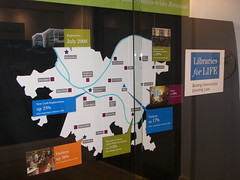 A promotion for the "Libraries for Life" campaign, Carnegie Library system, Pittsburgh. (Outside of the Director's Office, which is located in an accessible place on the first floor of the Main Library.)
A promotion for the "Libraries for Life" campaign, Carnegie Library system, Pittsburgh. (Outside of the Director's Office, which is located in an accessible place on the first floor of the Main Library.)I can't tell you how discouraging it was to visit the Carnegie Library in Pittsburgh. The recently renovated library, built in the 1930s maybe, is gorgeous. Meanwhile, our system languishes, and is operating under a planning process and plan that seems under-informed and not very pathbreaking. Not to mention that our city doesn't have much of a track record in the past few decades for quality construction and renovation of government-owned buildings.
Not so in Pittsburgh.
Note to people concerned about libraries in DC: the main library in Pittsburgh is renovated to "21st Century Library" standards. Whereas the leaders of the library system are arguing that such can't be done generally, that old library buildings haven't been renovated (also see as another example of renovation, the conversion of the Gimbel's department store into the Business Library in the NYC Public Library system).
It's warm and friendly.
And the system is engaged in renovating branch libraries too. Many are more than one floor. Whereas the DC Library plan insists on anti-urban one floor branch libraries.
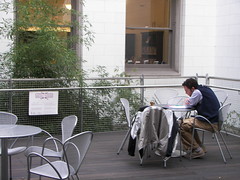 The Bamboo courtyard, Carnegie Library, Pittsburgh.
The Bamboo courtyard, Carnegie Library, Pittsburgh.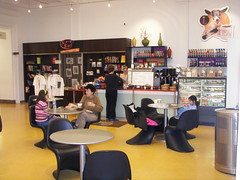 Cafe and gift shop, Carnegie Library, Pittsburgh.
Cafe and gift shop, Carnegie Library, Pittsburgh.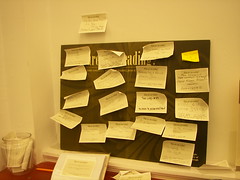 The library reaches out to readers. This board is for post-its where people write about the books that impact their lives.
The library reaches out to readers. This board is for post-its where people write about the books that impact their lives.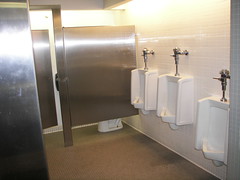 Unlike restrooms in the DC Public Library system, especially the main branch, the men's restroom at the Carnegie Library in Pittsburgh is nice and well-maintained. In a crazy innovation, there are even doors affixed to the stalls. Doors on restroom stalls are an amenity that restrooms in the DC main branch library lacks (or at least it used to--I haven't even stepped in the restrooms in this building for at least 10 years because they were so disgusting).
Unlike restrooms in the DC Public Library system, especially the main branch, the men's restroom at the Carnegie Library in Pittsburgh is nice and well-maintained. In a crazy innovation, there are even doors affixed to the stalls. Doors on restroom stalls are an amenity that restrooms in the DC main branch library lacks (or at least it used to--I haven't even stepped in the restrooms in this building for at least 10 years because they were so disgusting).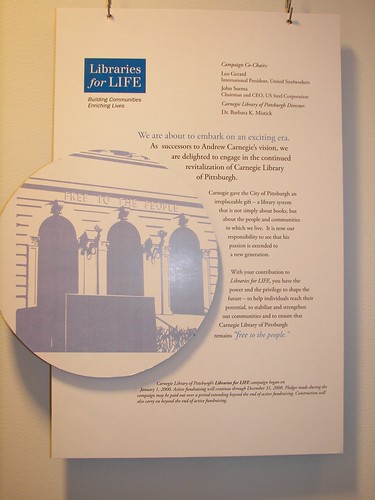 The Pittsburgh libraries work to engage citizens in the process of renewal from the outset.
The Pittsburgh libraries work to engage citizens in the process of renewal from the outset.In the current issue of DC North, there is an article, "The Problem of Homelessness," in the The Last Word feature, lamenting about the low quality of services to DC's homeless population. According to the article, one of the only daytime services provided is a bus that picks up homeless people and takes them to the Main branch of the DC Public Library.
One of my colleagues suggests that this is a form of a deliberately created nuisance (e.g., developers not maintaining buildings to justify demolition, or building owners moving in "bad tenants" such as drug dealers to drive out other tenants in order to clear a building for redevelopment) to justify shutting down the Martin Luther King Library. (*I call this the process of creating "noxious uses." and it's part of the general discussion of what I call "blaming the building.") Martin Luther King, Jr. Central Library, Washington, DC.
Martin Luther King, Jr. Central Library, Washington, DC.Don't get me wrong, as a library, the MLK is abominable. A building constructed as if it is merely an office building for books doesn't revere and respect books. On the other hand, I doubt that the currently provided plan to improve the Central Library by building a new facility will produce something that is any better. So maybe it is worth fixing and improving what we have, rather than taking on a crapshoot.
I hate to be accused of lack of vision, but there is a reason that reasonable people doubt the likelihood of success with the DC Government pulling off the construction not just of a new main library, but of a great new main library.
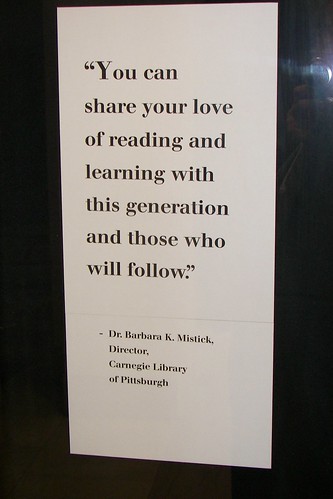
 Pittsburgh's Carnegie Library sponsors a wide variety of talks and presentations.
Pittsburgh's Carnegie Library sponsors a wide variety of talks and presentations.Index Keywords: libraries



0 Comments:
Post a Comment
<< Home